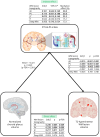Glymphatic System May Mediate the Relation Between Choroid Plexus and Brain Damage in Multiple Sclerosis
- PMID: 40472291
- PMCID: PMC12153948
- DOI: 10.1212/NXI.0000000000200414
Glymphatic System May Mediate the Relation Between Choroid Plexus and Brain Damage in Multiple Sclerosis
Abstract
Background and objectives: The choroid plexus (CP) regulates immune functions and produces most CSF that circulates in the brain parenchyma through perivascular spaces, part of the glymphatic system. In multiple sclerosis (MS), CP enlargement and glymphatic dysfunction are associated with inflammatory activity, clinical disability, and brain damage, but their interrelation is unclear. We investigated whether glymphatic system dysfunction mediates the association between CP enlargement and brain damage in patients with MS.
Methods: Brain fluid-attenuated inversion recovery, 3-dimensional T1-weighted, diffusion-weighted, and susceptibility-weighted sequences were obtained from 146 patients with MS and 72 healthy controls (HC). Glymphatic function was assessed using the diffusion along the perivascular space (DTI-ALPS) index, and CP volume was measured automatically.
Results: Patients with MS showed significantly higher white matter (WM) lesion and CP volumes (p < 0.001), and lower DTI-ALPS index, brain, WM, thalamic, and cortical volumes than HC (p ≤ 0.048). In patients with MS, higher CP volume correlated with a lower DTI-ALPS index (r = -0.305, false discovery rate p value = 0.001). Both measures were associated with higher total, periventricular, and juxtacortical (JC) WM lesion volumes (CP volume: r from 0.285 to 0.340, p-FDR ≤ 0.001; DTI-ALPS index: r from -0.301 to -0.444, p ≤ 0.001), and lower brain, thalamic, cortical, and WM volumes (CP volume: r from -0.246 to -0.405, p-FDR ≤ 0.006; DTI-ALPS index: from 0.269 to 0.497, p-FDR ≤ 0.003). The DTI-ALPS index partially mediated the associations of normalized choroid plexus volume with total, periventricular, and JC T2-hyperintense WM lesion volumes (standardized-β ranging from 0.073 to 0.115, relative effect ranging from 25.2% to 33.6%) and normalized brain, thalamic, cortical, and WM volumes (standardized-β ranging from -0.086 to -0.125, relative effect ranging from 25.3% to 52.7%).
Discussion: In MS, enlarged normalized CP volume may contribute to brain damage accumulation possibly through the promotion of a chronic proinflammatory state and the mediation of glymphatic system dysfunction.
Conflict of interest statement
The authors declare that they have no competing interests in relation to this work. Potential conflicts of interest outside the submitted work are as follows: P. Preziosa received speaker honoraria from Roche, Biogen, Novartis, Merck, Bristol Myers Squibb, Genzyme, Horizon, and Sanofi; and has received research support from Italian Ministry of Health and Fondazione Italiana Sclerosi Multipla. E. Pagani has nothing to disclose. M. Margoni reports personal fees from Sanofi Genzyme, Merck Serono, Roche, Biogen, and Novartis. M. Rubin, L. Storelli, and G. Corazzolla have nothing to disclose. M.A. Rocca received consulting fees from Biogen, Bristol Myers Squibb, Eli Lilly, Janssen, and Roche; received speaker honoraria from AstraZaneca, Biogen, Bristol Myers Squibb, Bromatech, Celgene, Genzyme, Horizon Therapeutics Italy, Merck Serono SpA, Novartis, Roche, Sanofi, and Teva; receives research support from the MS Society of Canada, the Italian Ministry of Health, the Italian Ministry of University and Research, and Fondazione Italiana Sclerosi Multipla; and is an associate editor for
Figures





References
MeSH terms
LinkOut - more resources
Full Text Sources
Medical
Miscellaneous
